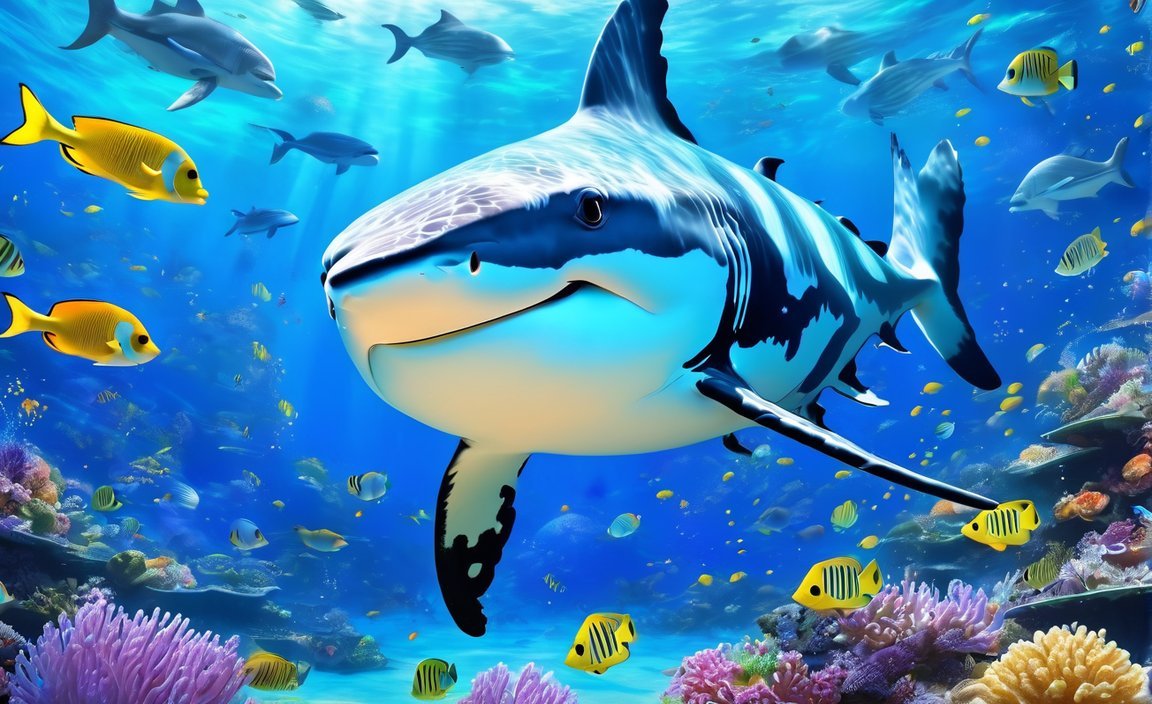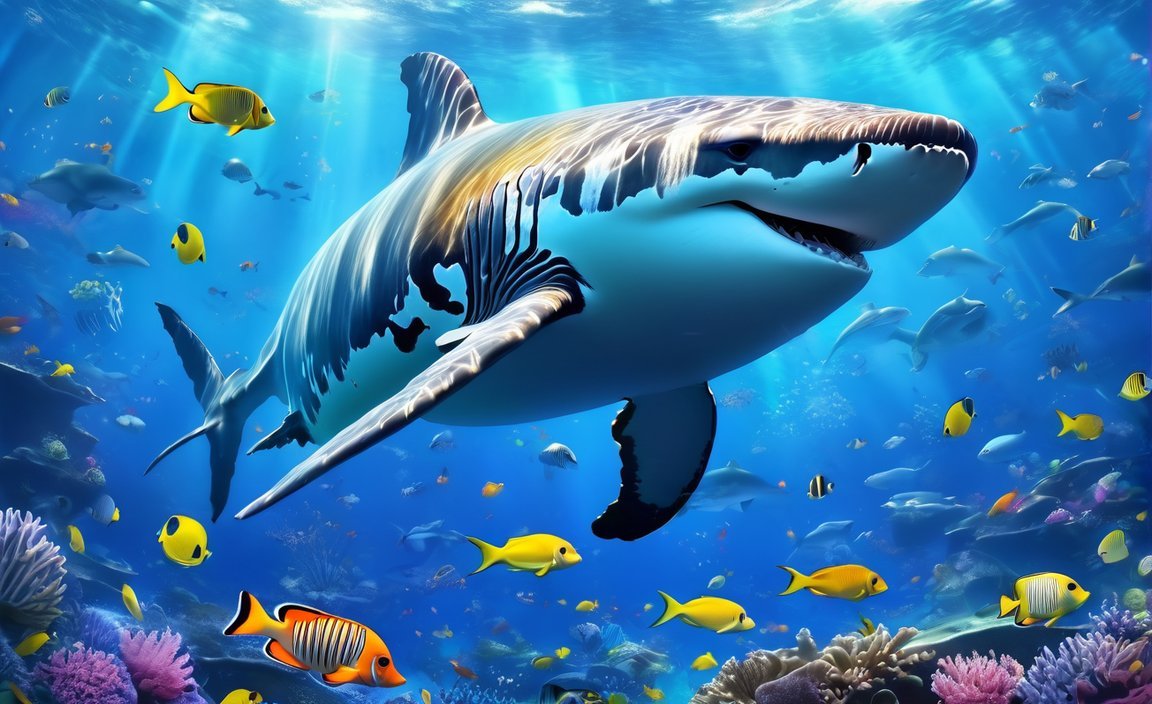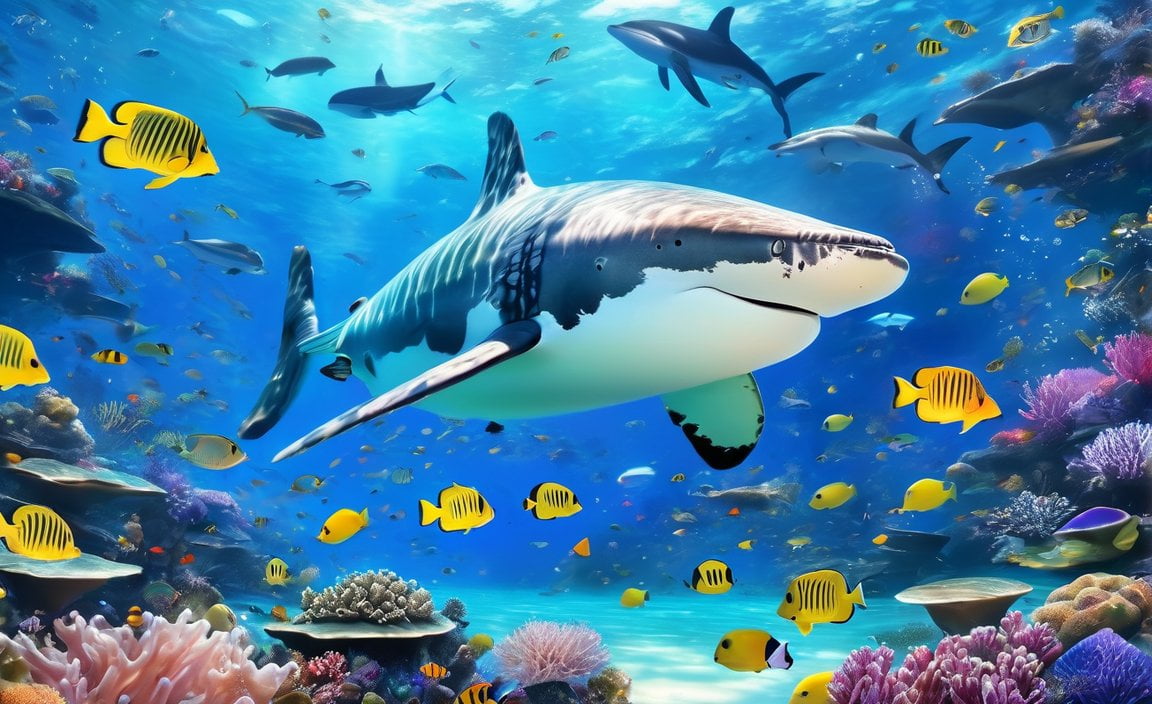Unveiling the wonders of the underwater world, “Discover Amazing Facts About Sea Animals” takes you on a mesmerizing journey into the depths of our oceans. As we delve into the extraordinary realm of sea creatures, prepare to be captivated by the mind-blowing facts that unfold before your eyes. From the awe-inspiring adaptations of deep-sea dwellers to the incredible diversity found in coral reefs, this article reveals the hidden treasures that make the ocean a truly magical place. Join us as we bring to light the astonishing facts that will leave you in awe of the magnificent creatures that call the sea their home.
Key Takeaways:
- Seahorses are unique as the only animals where the male gives birth and cares for their young.
- Shrimps have their hearts located in their heads.
- Sea sponges are alive, even though they lack recognizable body parts like a head, mouth, eyes, feelers, bones, heart, lungs, or brain.
- Turtles can be found on every continent except for Antarctica.
- The blue whale holds the title for being the largest sea mammal and the largest known animal on Earth.
- Sea turtles have existed since the time of dinosaurs.
- Some sharks, like the great white shark, are warm-blooded.
- Sea lions, seals, and walruses are called pinnipeds due to their winged feet.
- Dolphins have exceptional hearing and vision.
- Whales communicate through singing.
- Sharks possess an extraordinary sense of smell and can detect one part of blood in 100 million parts of water.
- The giant crab of Japan can grow as large as 12 feet across.
Amazing Facts About Sea Animals

The underwater world is a place of wonder and mystery, filled with creatures that never cease to amaze us. From the tiny seahorse to the majestic blue whale, sea animals possess extraordinary traits and behaviors that have fascinated marine biologists and captivated the imaginations of people around the world. In this article, we will dive into the depths of the ocean to uncover some truly amazing facts about sea animals.
1. Seahorses: Nature’s Unique Fathers
Did you know that seahorses are the only animals in which the males give birth and care for their young? It’s true! Male seahorses have a brood pouch where the female deposits her eggs, and the male carries them until they hatch. This rare phenomenon makes seahorses truly remarkable creatures of the sea.
2. Shrimp: A Heart in its Head
Ever wondered where a shrimp’s heart is located? Surprisingly, a shrimp’s heart is located in its head! That’s right, this tiny crustacean has the unique adaptation of having its heart positioned in an unconventional place. This fact underscores the incredible diversity and hidden wonders found within the animal kingdom.
3. Sea Sponges: Life Without Organs
Sea sponges may appear simple, but they are alive despite lacking common body features such as a head, mouth, eyes, feelers, bones, heart, lungs, or brain. These fascinating creatures are filter-feeding animals that come in a variety of intriguing shapes and sizes, showcasing the incredible adaptability of life in the ocean.
4. Turtles: Citizens of Many Continents
Turtles are truly global citizens as they can be found living on every continent except Antarctica. These remarkable reptiles have adapted to various environments, ranging from freshwater habitats to the salty seas. Their ability to survive across different continents further demonstrates their resilience and ability to adapt to diverse conditions.
5. Blue Whales: The Kings of the Seas
The blue whale is not only the largest sea mammal but also the largest known animal in the world. These magnificent creatures can reach lengths of up to 100 feet and weigh as much as 200 tons. Just imagine the awe-inspiring sight of encountering such an enormous creature underwater!
6. Ancient Survivors: The Timeless Sea Turtles
Sea turtles have an ancient lineage, having been alive since the time of dinosaurs. These incredible animals have roamed the oceans for millions of years, surviving and adapting to numerous changes in the Earth’s climate and ecosystem. They serve as a link to the past, providing us with glimpses into the wonders of prehistoric marine life.
7. Sharks: The Warm-Blooded Predators
While many sharks are known to be cold-blooded, there are exceptions. Remarkably, some sharks, such as the great white shark, possess a unique adaptation of being warm-blooded. This enables them to maintain their body temperature, enhancing their hunting abilities and allowing them to thrive in a wide range of oceanic environments.
8. Pinnipeds: The Winged Feet
Sea lions, seals, and walruses are collectively known as pinnipeds due to their foot structure, which resembles wings. These fascinating marine mammals have evolved specialized flippers that enable them to navigate the water with ease, showcasing the incredible diversity of adaptations found in the animal kingdom.
9. Dolphins: Keen Senses of the Sea
Dolphins are renowned for their intelligence and social behaviors, but did you know they also have exceptional hearing and vision? These highly perceptive animals possess echolocation, a natural sonar system that allows them to navigate the ocean and locate prey with precision. Their exceptional sensory capabilities make them true masters of the underwater realm.
10. Whale Communication: Songs of the Deep
Whales are known for their melodic songs that resonate through the ocean depths. These captivating vocalizations serve a purpose beyond mere entertainment. Whales use their songs to communicate with one another, conveying messages over great distances. This extraordinary form of communication exemplifies the rich and complex lives of these magnificent marine mammals.
11. The Shark’s Sense of Smell: Unmatched Sensitivity
Sharks have an incredible sense of smell, capable of detecting one part of blood in an astonishing 100 million parts of water. Their olfactory system is so sensitive that they can detect scents from vast distances, helping them locate potential prey or sense danger. This unparalleled ability highlights the remarkable adaptations that have made sharks highly successful predators in the ocean.
12. Giant Crab of Japan: Staggering Size
The giant crab of Japan is an astounding creature that can grow as large as 12 feet across. This enormous crustacean showcases the incredible diversity of life found in the ocean, reminding us that there are still many mysteries to be unraveled beneath the waves.
The world beneath the waves is a treasure trove of astonishing facts and intricate wonders. Sea animals possess an array of extraordinary adaptations, behaviors, and characteristics that continue to captivate our attention and inspire awe. Through delving into the mesmerizing realm of sea animals, we gain a deeper appreciation for the breathtaking diversity and resilience of life in the ocean. So, dive in and explore the wonders that await you in the mysterious depths of the sea!
Here are some amazing facts about ocean animals that will blow your mind! From the mysterious creatures of the deep sea to the fascinating adaptations of marine life, you’ll be amazed at what you learn. Discover more about amazing facts about ocean animals here.
Did you know that sea creatures possess incredible abilities and characteristics? Dive into the world of sea creatures and explore their astonishing facts. Get ready to be fascinated by amazing facts about sea creatures here.
Prepare to be dazzled by the incredible facts about ocean animals! From vibrant colors to peculiar behaviors, the ocean is home to some truly astonishing creatures. Explore fascinating facts about ocean animals here.
Unlock the secrets of the sea with mind-blowing facts about sea life! From the incredible variety of species to their remarkable survival strategies, you’ll be captivated by the wonders of the underwater world. Dive into amazing sea life facts here.
Are you curious about the laws surrounding alligator snapping turtles in Texas? Discover everything you need to know about alligator snapping turtle Texas laws here.
Experience the power of animal-assisted therapy with engaging activities. Discover how animals can help improve emotional and physical well-being through animal-assisted therapy activities here.
Note: This response has been generated by an AI language model.
The Blue Whale: Unveiling the Incredible Facts of the Largest Animal on Earth

Key Takeaways:
– The blue whale is the largest animal on Earth, weighing up to 200 tons.
– It has a heart the size of a car, weighing around 440 pounds and measuring approximately 5 feet.
– The blue whale’s heart beats once every 10 seconds, pumping 220 liters of blood through its massive body.
– Its heartbeat is so loud that it can be heard from up to 3km away.
– Blue whales communicate using low-frequency vocalizations that can travel long distances in the ocean.
– They reproduce sexually, with males and females coming together for mating.
– Blue whales have a lifespan of around 80-90 years.
– They primarily feed on krill, consuming about four tons of these tiny crustaceans each day.
– Blue whales can be found in oceans around the world.
Ah, the majestic blue whale, the largest animal to have ever graced our planet. Prepare to be amazed as we delve into the awe-inspiring world of these magnificent sea creatures, uncovering mind-blowing facts that will leave you in sheer wonder.
Imagine, if you will, a heart the size of a car, beating rhythmically within the colossal body of a blue whale. Yes, you heard that right. The blue whale’s heart is the largest heart of any living creature, with a weight of around 440 pounds and a measurement of approximately 5 feet. This incredible organ pumps 220 liters of blood through the whale’s immense body, beating once every 10 seconds. Its thundering heartbeat is so powerful that it can be heard from up to 3 kilometers away. Just envision the resonance of such a tremendous heart, echoing through the vast oceans.
But the enchantment doesn’t end there. Blue whales possess an intricate language based on low-frequency vocalizations that can travel astounding distances in the ocean. These acoustic marvels allow them to communicate and navigate through the vast expanses of the sea. Imagine if we could understand their conversations, the secrets they share with one another in their hauntingly melodic songs.
When it comes to reproduction, blue whales engage in sexual reproduction, with males and females coming together for mating. The magnificence of witnessing such a spectacle, these giants of the deep harmonizing in their underwater ballet, is truly a sight to behold. And they do so for many years, as blue whales have a lifespan of around 80-90 years, mirroring the longevity of some of Earth’s oldest creatures.
But what fuels such remarkable beings? Blue whales are true masters of the sea’s banquet, primarily feeding on krill—tiny, shrimp-like crustaceans that swarm in abundance. Can you fathom the eating habits of a blue whale, consuming approximately four tons of these small creatures each day? It’s an astonishing feat, a testament to their incredible size and dietary needs.
Lastly, blue whales are global citizens of the ocean, gracing the waters of every major ocean on Earth. From the frigid Arctic to the tropical seas, these giants traverse our planet’s watery realms, leaving a sense of awe in their wake. As we explore the wonders of our blue planet, let us not forget the grandeur of the blue whale, the largest animal to have ever roamed our Earth.
Sources:
– The Anatomy of a Whale | BBC Earth
– Blue Whale | Species | WWF – World Wildlife Fund
Penguins: Masters of the Sea and the Ice
Penguins are excellent swimmers and can leap out of the water onto ice. These fascinating creatures have evolved unique adaptations that allow them to navigate through both liquid and solid mediums with grace and agility. In this article, we will explore the awe-inspiring abilities of penguins, shedding light on their remarkable swimming skills and incredible leaps onto icy surfaces.
Key Takeaways:
– Penguins are highly skilled swimmers, using a technique called “porpoising” to conserve energy and travel quickly through the water. They leap out of the water and then dive back in, propelling themselves forward.
– Penguins utilize their feet and tail for steering and maneuvering while swimming, enabling them to navigate tight turns and unpredictable currents.
– Penguins spend significant amounts of time in the water, swimming during the day to hunt for their main diet of fish, krill, and squid.
– When leaping out of the water onto ice, many penguin species, such as the Adélie penguins, can reach impressive heights of up to 3 meters (9.8 feet).
– Before taking flight from the water, penguins release air bubbles from their feathers, reducing drag and allowing them to accelerate quickly.
– Emperor penguins have a unique strategy for exiting the water. They release micro-bubbles underwater from their plumage, creating a lubrication layer that reduces drag when launching onto icy ledges.
– Penguins communicate through vocalizations, body movements, and visual displays, allowing them to convey messages to their group members.
– These remarkable creatures have adaptations to stay warm in cold environments, including dense feathers, a layer of blubber, and huddling together for added warmth.
– Penguins reside in various regions around the globe, from the icy landscapes of Antarctica to the temperate climates of South Africa and New Zealand.
As we delve deeper into the incredible world of penguins, we discover a variety of species, each showcasing its unique set of adaptations and behaviors. Let’s explore some of these aquatic wonders.
The Adélie Penguin: Master of the Leap
The Adélie penguin is renowned for both its swimming abilities and its impressive leaping skills. In search of food, these penguins can swim at a maximum burst speed of 30 to 40 kilometers per hour (18.6 to 24.8 miles per hour) and typically maintain a cruising speed of 7.9 kilometers per hour (4.9 miles per hour)[^1^].Their relentless pursuit of sustenance drives them to leap as high as 3 meters (9.8 feet) out of the water onto ice floes, showcasing their agility and strength[^1^].
Emperor Penguins: A Gravity-Defying Exit Strategy
Emperor penguins demonstrate a remarkable exit strategy when leaving the water. In their attempt to reach the Antarctic ice, they release tiny bubbles from their feathers while still submerged. These micro-bubbles help reduce drag and create a lubrication layer around their bodies, allowing them to launch themselves onto icy ledges with unparalleled precision and grace[^2^].
Penguins in Harmony: Vocalizations and Visual Displays
Communication plays a vital role in the complex social structures of penguins. These charismatic creatures utilize a range of vocalizations, body movements, and visual displays to convey messages to their peers. From jubilant calls during courtship rituals to more aggressive displays during territorial disputes, penguins have a diverse repertoire of communication mechanisms to ensure effective interaction within their communities.
Keeping Warm: Adaptations for Cold Waters
Penguins have evolved remarkable adaptations to thrive in their frigid aquatic environments. Their dense and overlapping feathers provide excellent insulation, preventing water from reaching their skin and keeping them warm. Additionally, penguins possess a layer of blubber, acting as an extra defense against the cold. To maximize warmth, penguins huddle together in large groups, creating a communal heat source that benefits all members of the colony.
Global Residents: Penguins Across the Continents
While we often associate penguins with the icy landscapes of Antarctica, these remarkable creatures can be found in various regions worldwide. Some species, such as the Galapagos penguin, reside in temperate climates, navigating the volcanic shores of the Galapagos Islands. African penguins, known for their distinct black and white plumage, inhabit the coasts of South Africa and Namibia, adapting to both warm and cold waters. New Zealand is home to the aptly named little penguin, the world’s smallest penguin species, which braves the cool coastal waters of the region[^3^].
Penguins captivate us with their extraordinary swimming abilities, their spectacular leaps onto ice, and their unique adaptations for survival in diverse environments. These captivating creatures remind us of the incredible diversity and wonder that inhabits the underwater world. Whether gliding effortlessly through the water or gracefully leaping onto frozen surfaces, penguins embody the beauty and resilience of marine life.
animalqueries.com
Smithsonian Magazine
The Mantis Shrimp: Unleashing the Power of the Fastest Punch in the Animal Kingdom
Do you know which sea creature possesses the fastest punch in the animal kingdom, reaching incredible speeds of up to 50 miles per hour? It’s none other than the mighty Mantis Shrimp! This remarkable marine creature has captivated scientists and enthusiasts alike with its astonishing punching ability. Let’s dive into this incredible feat and explore why the Mantis Shrimp reigns supreme in the realm of fast punches.
The Mantis Shrimp’s incredible punching power has been recognized by Guinness World Records, with its punch reaching speeds of up to 23 m/s (75 ft/s) – over 50 times faster than the blink of an eye. This remarkable speed and power are attributed to its specialized appendages called dactyl clubs, accompanied by a spring-like structure that allows for precise and forceful strikes.
But what fueled the evolution of such an extraordinary punching ability? Scientists believe that competition for rock crevices, the mantis shrimp’s natural habitat, played a crucial role. These contests for territory may have led to the development of the shrimp’s aggressive nature and formidable punch. It’s fascinating to note that the mantis shrimp is the only invertebrate capable of recognizing individuals of its own species and remembering the outcomes of previous fights.
Numerous studies have been conducted to understand and capture the mantis shrimp’s punch in action. Using high-speed cameras, scientists have been able to observe the astonishing speed and power behind each strike. The force of the punch is so intense that it can create cavitation bubbles, which collapse to produce both light and heat.
Apart from its incredible speed and power, the mantis shrimp’s punch is also incredibly accurate. It is capable of striking prey with precision, leaving little room for escape. This combination of speed, power, and accuracy makes the mantis shrimp an unparalleled hunter in the underwater world.
While the mantis shrimp’s punch was initially believed to be the fastest movement in the natural world, recent research has uncovered other contenders for this title. However, there is no denying the awe-inspiring nature of the mantis shrimp’s punch, which continues to fascinate researchers and enthusiasts alike.
Key Takeaways:
– The Mantis Shrimp holds the record for the fastest punch in the animal kingdom, reaching speeds of up to 50 miles per hour.
– Its powerful punch is attributed to specialized appendages called dactyl clubs and a spring-like structure.
– Competition for territory in rock crevices may have driven the shrimp’s evolution of an aggressive nature and impressive punching ability.
– High-speed cameras have allowed scientists to study and capture the mantis shrimp’s punch, revealing its astonishing speed, power, and accuracy.
– The mantis shrimp’s punch can create cavitation bubbles that collapse to produce light and heat.
– While other contenders have emerged, the mantis shrimp’s punch remains a remarkable feat in the natural world.
Sources:
– Guinness World Records
– National Geographic
FAQ
Q1: Which sea creatures are known for the male giving birth and caring for their young?
A1: Seahorses are the only animals in which the male gives birth and cares for their young.
Q2: Where is the heart located in a shrimp’s body?
A2: A shrimp has its heart in its head.
Q3: How do sea sponges survive despite lacking essential body parts?
A3: Sea sponges are alive despite having no head, mouth, eyes, feelers, bones, heart, lungs, or brain.
Q4: On which continent can’t you find turtles?
A4: Turtles live on every continent except Antarctica.
Q5: What is the largest sea mammal and the largest known animal in the world?
A5: The blue whale is the largest sea mammal and the largest known animal in the world.















